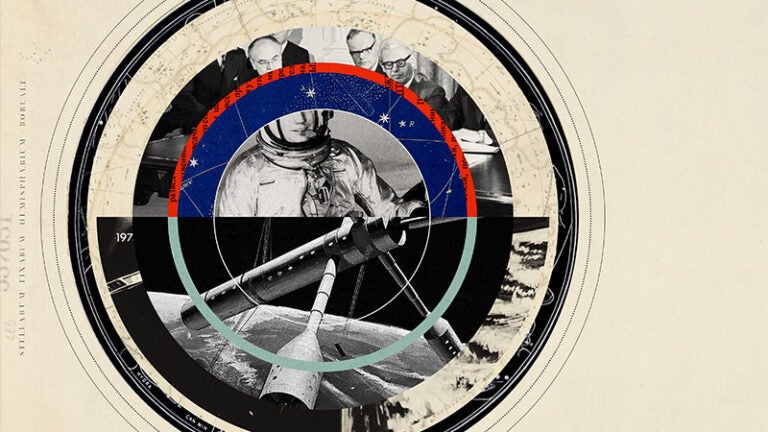
Who Owns the Universe?
In early 1610, Italian astronomer and physicist Galileo Galilei wrote a letter to Cosimo de’ Medici — then Grand Duke of Tuscany — stating that he had observed four moons of Jupiter (which Galileo initially believed to be stars) using his improved telescope lens. Hoping to secure the grand duke’s patronage, Galileo proposed naming the bodies after Cosimo’s family, eventually calling them the “Medicea Sidera,” or the Medicean stars. (In the end, the moons were named for four lovers of the god Zeus: Io, Europa, Ganymede and Callisto.)
Galileo was not the first to claim stars in the name of people on Earth, and he was to be far from the last. Although the names of celestial bodies are now determined by the International Astronomical Union using a systematic naming system, the idea that outer space is terra incognita, a place yet unexplored or claimed, where everything is up for grabs, is more powerful today than ever before.
Countries, companies and even individuals are all sizing up the expanse beyond Earth’s atmosphere as a place of nebulous possibility: a potential source of minerals, a new space to further national interests or even a place for future habitation. But how we end up exploring space will be defined not just by ambition and competition, but by scientific realities that argue in favor of advanced telescopes, and robotic astronauts over ones made of flesh and blood.
NATIONAL PROJECTIONS
The modern space era took flight in October 1957, when the Soviet Union launched Sputnik, the world’s first satellite. The event had immediate repercussions back on Earth. Alarmed by the Soviets’ technological prowess and its ramifications for their military strength, the United States accelerated not only its space program but also its weapons capability, shifting the Cold War into high gear.
Ever since, outer space has been the backdrop for a human melodrama that has exposed our best and worst traits. For decades, astronauts and scientists from around the world have worked together to unlock the mysteries of space. Nowhere is that cooperation more evident than with the International Space Station (ISS). Launched 23 years ago, the ISS has been as much a political as a technological marvel. The U.S., Russia, Europe, Japan and Canada jointly operate the space station, while astronauts from 19 countries have visited the orbital laboratory.
More recently, the long-awaited advent of space tourism has started to unfold. Actor William Shatner, who, as Captain James T. Kirk on the iconic television series Star Trek, piloted the U.S.S. Enterprise as it boldly went where no man (or woman) had gone before, recently became the oldest man to fall to Earth thanks to a private rocket ride aboard the Blue Origin suborbital capsule — the space tourism project developed and financed by Amazon billionaire Jeff Bezos.
But the final frontier has also played host to national ambitions that reflect an ongoing jockeying for power among some of the world’s most powerful nations.
Whereas the space race was once a two-country event between the U.S. and the Soviets, it is now multipolar, with China, India and other nations investing heavily in space exploration in the late 20th and early 21st centuries. Currently, 72 nations have government space programs, with capabilities ranging from satellite operation to full launch of spacecraft.
“We are all ramping up our ambition,” says Robert English, associate professor of international relations, Slavic languages and literatures and environmental studies at USC Dornsife. “In the U.S., we have rovers on Mars, we’ll be launching the [James] Webb space telescope soon and the Lunar Gateway will eventually serve as a spaceport for manned exploration of the moon, Mars and maybe beyond. China has moon and Mars rovers, too, plus the Heavenly Palace Space Station, while Russia continues a smaller though active space program of its own.”
And while collaborative projects, such as the ISS, have aimed to foster a sense of scientific cooperation rather than competition, terrestrial political alliances and divisions certainly carry over into space, English notes. In June, Russia threatened to pull out of the ISS and build its own space station if the U.S. didn’t drop sanctions on its space program and the microchips it needed to launch its rockets. (Officials reportedly later said such a withdrawal would not happen.) More worrisome to the U.S. are Chinese or Russian anti-satellite capabilities, English says. Meanwhile, those two countries are worried about America’s Space Force and secretive space plane project.
“What if we didn’t think about space in terms of ownership at all?”
Does such maneuvering signal that space is poised to become a new arena for national turf wars, or does it represent little more than empty political point-scoring? The reality is probably somewhere between the two, English says. Looking at China’s space program as an extension of its Belt and Road initiative to foster international relationships through joint infrastructure programs on Earth, rather than as a sign of some looming interplanetary imperial ambition, for example, helps avoid alarmist interpretations of the situation.
“We swing from complacency to hysteria, and maybe the proper reaction is somewhere in the middle,” English says. “There’s no doubt that what other countries are doing and how we perceive what they’re doing are two different things, and both are strongly colored by our relationship on Earth.”
English is concerned these exaggerated reactions to other nations’ space projects could create a hostile international environment similar to the nuclear arms race of the 1950s and ’60s, with countries loading up their budgets with space-based weapons and defense systems. Meanwhile, the Outer Space Treaty, to which 111 nations are parties and another 23 are signatories, places some limits on military activities in space but is much vaguer on issues such as space mining and ownership of resources. In addition, five countries — China, Russia, the U.S., India and North Korea — are actively working on hypersonic missiles that may further stretch the treaty by placing warheads in a partial or “fractional” orbit of the Earth, English notes.
“If nations have a confrontational attitude, we will quickly be bumping into each other and saying, ‘No, I claimed that first. Who says you can claim this? No, we don’t agree to that part of the treaty, we didn’t sign that annex,’” English says. “We need a conference of at least the leading space powers to figure out the likeliest points of friction and work out the rules of the road.”
FOR ALL OR FOR NONE?

While a handful of countries and wealthy individuals are flexing their cosmic muscles, the fact is that space really belongs to everyone — or perhaps to no one, says Andrea Ballestero, associate professor of anthropology. The idea of space being an open field, full of unowned things that can belong to the first to claim them, is a dangerous echo of the tenets behind the so-called Age of Exploration, when European powers laid claim to lands in, among other places, the Americas and Australia.
Being a billionaire or a powerful nation are not traits that confer entitlement to outer space, Ballestero argues. Rather than focus on the concept of astronomical bodies and objects as potential property, she suggests, individuals, companies and nations should view space similarly to entities like oceans — places that don’t have an owner but are regulated through many international treaties.
“The blueprint is to put aside the idea that this is about who claims private property, and instead adopt the framework that this is a collective problem or a collective possibility, one which cannot be reduced to the interests of one player,” Ballestero says. “We can deal with that as a global community.”
THE OUTER LIMITS
While one can speculate about the chances of Russia — or billionaire and space entrepreneur Richard Branson — establishing a colony on Mars or setting up a mining base on the moon, the health implications for the human body of long-duration exposure to the hazards of space make such speculative projects highly unlikely to come to fruition, at least for the foreseeable future, says Kenneth Phillips, adjunct professor of the practice of physics and astronomy at USC Dornsife and curator for aerospace science at the California Science Center.
Beyond low Earth orbit, astronauts are exposed to high levels of cosmic radiation, placing them at higher risk for cancer and cardiovascular disease. Meanwhile, in a microgravity environment, the body’s fluids tend to redistribute themselves uniformly, which can cause problems with rapid fluid loss and even result in deformation of the eyes. Microgravity itself is correlated with loss of muscle mass, which can affect heart health and bone density, among other things. Finally, there’s the issue of time: Even if humans were capable of traveling to Jupiter in spacecraft far more advanced than what we have now, such a trip might take at least five years, meaning an astronaut would need to devote a decade of their life just to getting to and from the mission site.
Experts in the field agree on the importance of space exploration — an endeavor that requires a relatively small portion of our country’s budget and has been the impetus for many revolutionary inventions. However, as astrophysicist and USC Dornsife Dean Amber D. Miller notes, the astrophysics and planetary science communities agree that manned space travel is impractical due to the vast timescales, the radiation environment in our solar system and the astronomical expense. Space exploration should be done primarily using robotics and advanced telescopes — the only way to study space outside our solar system. Robotic probes, such as NASA’s Juno probe and the Mars exploration rovers, are a safer and more efficient way to study the environment within our own solar system.
Although the argument for manned space flight anywhere beyond the orbit of Earth is very weak from a scientific standpoint, it remains popular among the general public — something governments have eagerly encouraged. More than a few Russian-language posters from the 1960s mention the “glory” that Soviet cosmonauts brought to the USSR, with at least one featuring a moon or planet bearing the Soviet Union’s Russian abbreviation “CCCP” stamped on it. Meanwhile, the image of astronauts Buzz Aldrin and Neil Armstrong planting the American flag on the moon during the 1969 landing is one of the most iconic of the era.
As Phillips notes, maintaining broad public support for space programs is important to preserve NASA funding.
“Try to imagine other areas of scientific research in which the public is as emotionally invested as space exploration,” Phillips says. “You need to make sure that you have a base of the population that says, ‘Yes, NASA’s work is worth doing.’” For that reason, some manned space flights are likely to continue for the foreseeable future.
UNDERSTANDING THE COSMOS
Humanity’s desire to solve the mysteries of space is unlikely ever to fade, nor will our attempts to explore, catalogue, photograph and understand the cosmos. Ballestero says that while people on Earth may try to claim this rock or that star in the name of their country, company or selves, we need to resist the urge to divide up space materials like so many spoils.
“What if we didn’t think about space in terms of ownership at all?” she suggests. “It doesn’t belong to anybody, but that doesn’t mean a group of humans should try to appropriate it.”
Because after all, who says we’re even alone out there?